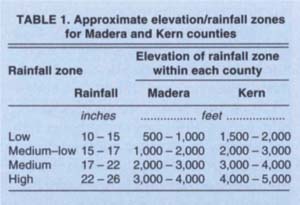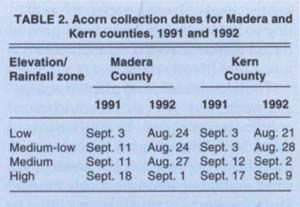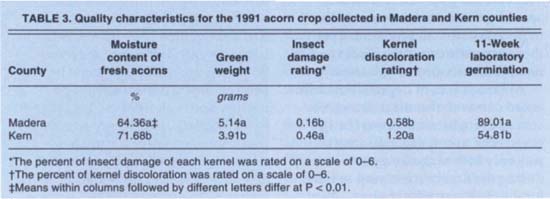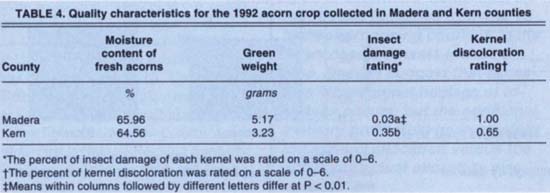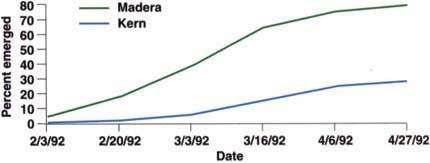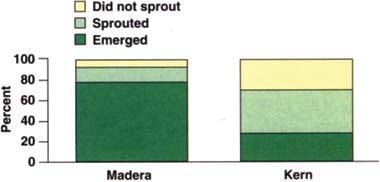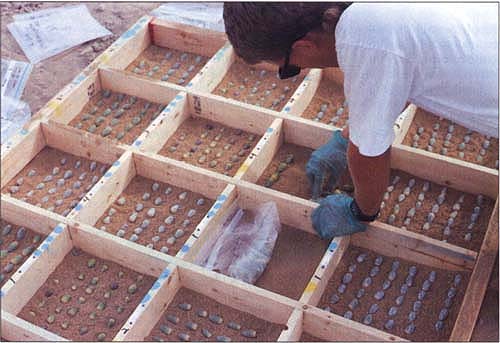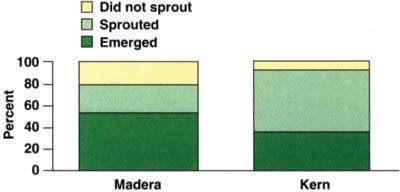All Issues
Blue oak acorns more viable in Madera County than Kern County
Publication Information
California Agriculture 49(5):18-21. https://doi.org/10.3733/ca.v049n05p18
Published September 01, 1995
PDF | Citation | Permissions
Abstract
Acorns from native blue oaks growing in Madera and Kern counties were evaluated for quality in this 2-year study. Acorns from Madera County were larger and more of their seedlings emerged from the soil and at a faster rate than acorns from Kern County. Insect infestation and disease in the acorns were not consistent during the study.
Full text
Landowners, government agencies and conservation groups all have a great deal of interest in the natural regeneration of blue oaks (Quercus douglasii). About 80% of the oak woodlands and hardwood rangelands in the South Sierra foothills are privately owned. Many of these landowners are interested in managing their lands to sustain or increase blue oak stands.
Standiford et al. (see California Agriculture, January-February 1991) conducted an inventory survey of oaks in four southern San Joaquin Valley counties (Madera, Fresno, Tulare and Kern). They found the number of blue oak seedlings per acre was lowest at the low elevation/rainfall zone; highest at the medium-low elevation/rainfall zone; and slightly lower at the medium and high elevation/rainfall zones. Seedlings were defined as shorter than 1 foot.
We designed this study to evaluate blue oak acorn quality from the northern and southern extremes (Madera, Kern) of Standiford's study area, in addition to evaluating the effect of elevation on acorn quality.
Collection and planting
We conducted the study using two different acorn crop years, 1991 and 1992. There were minor changes in the study between the two years. Except for where otherwise noted, the study procedures were the same for both years.
Acorn collection
In both counties, we collected acorns in each of the four elevation/rainfall zones (table 1). Each of the eight collections was represented by 400 acorns, 80 from each of 5 trees (3,200 total). Acorns were randomly picked from trees that rated 3 or higher, using the rating system described in the UC IHRMP Publication Preliminary Guidelines for Managing Hardwood Rangeland. In the 1991 Kern County collection year, trees rating 3 or higher could not be found at the higher elevation zones, so samples consisted of a composite of several trees. In 1992, all trees from which acorns were collected rated 3 or higher.
Acorns were collected by elevational zone on approximately the same date in 1991, but collection in 1992 was based on moisture content of the acorns (table 2). During 1992, 10 acorns were tested for moisture prior to sampling. Acorns were collected after moisture content had dropped to below 65%.
We stored all samples in plastic zipper freezer bags. Each tree sample was subdivided into two 40-acorn samples and resealed. One group of 40 was stored at 40°F for a minimum of 6 weeks. The remaining acorns were used for laboratory analysis.
Planting
The chilled samples were planted in outdoor germination boxes (1 foot by 1 foot by 4 inches) on November 3, 1991, and October 16, 1992. We placed the acorns on their sides in 2 inches of coarse sand, then covered them with 2 more inches of sand. Supplemental water was applied to maintain a moist environment. Emergence readings were made at 2-week intervals after the first shoot emerged.
Field germination
Acorns from the germination frames were dug up and evaluated on May 15, 1992 and June 8, 1993. We placed them in one of three categories: Emerged (shoots had emerged through soil and had green pigment); Sprouted (roots or shoots were present); or Did Not Sprout. In 1992 a fourth category was added: Sprouted and Died.
Laboratory acorn evaluation
We used 25 acorns from the individual tree laboratory samples to determine moisture content, insect damage and kernel discoloration.
Insect damage and kernel discoloration (an indication of fungal or bacterial damage) were rated on a scale of 0 to 6, with 0 indicating no damage and 6 indicating severe damage.
The remaining 15 acorns were used to evaluate laboratory germination. We placed the acorns in a plastic box with moist vermiculite, and determined percent germination after 11 weeks. Laboratory germination was not determined for the 1992 crop.
Madera and Kern compared
1991 crop
Table 3 shows the results of the laboratory analysis of acorns collected in 1991. Acorns collected on approximately the same date from Madera County were significantly lower in moisture than those from Kern County (64.36% vs. 71.68%). Also, acorns from Madera County weighed significantly more than those from Kern County (5.14 g vs. 3.91 g). Although the level of insect damage was low for both counties, the Kern County rating was almost three times higher than the Madera County rating (0.46 vs. 0.16). Kern County acorns had a rating of 1.20 for discoloration, which was about twice as high as the Madera County rating (0.58). The same trend of poorer quality acorns from Kern County was evident in the 11-week laboratory germination test (54.81% Kern vs. 89.01% Madera).
Acorns from Madera also emerged earlier and at a faster rate than those from Kern (fig. 1). This difference was significant from February 3, 1992, through April 27, 1992.
The final emergence data (May 15, 1992) showed that 79.25% of the acorns from Madera emerged as compared to 28.70% from Kern (fig. 2). However, a larger percentage of the Kern acorns (41.30%) sprouted but did not emerge, compared to Madera acorns (12.25%). Madera County had a smaller percentage of acorns that did not germinate (8.50% in Madera vs. 30.0% in Kern).
Elevation did not affect the moisture content of the acorns, insect damage rating, kernel discoloration, emergence, sprouting or not sprouting. However, elevation did affect percentage of acorns that germinated at 11 weeks in the laboratory. Low, mediumlow and medium elevations all had higher germination rates than did the high elevation (80.0%, 74.7%, 83.3% and 49.6% respectively). The high elevation had acorns (3.38 g) significantly smaller than the low elevation (4.81 g) and medium-low elevation (4.62 g), but not the medium elevation (3.98 g). The medium elevation was not significantly different from any of the other elevations.
Fig. 1. The average percent emergence of seedlings by date for Madera and Kern counties for the 1991 crop.
Fig. 2. The average percent of acorns that sprouted, emerged or did not sprout for Madera and Kern counties for the 1991 crop.
1992 crop
Table 4 shows the laboratory data for the 1992 crop quality. There was no significant difference in average moisture content of fresh acorns for the two counties (65.96% Madera vs. 64.56% Kern). Also, there was no significant difference in green acorn weight (5.17 g Madera vs. 3.23 g Kern). The lack of a significant difference in green acorn weight was due to the large degree of variability in the 1992 crop at both sites. The insect damage rating for Kern acorns was more than 10 times higher than that for Madera acorns (0.03 Madera vs. 0.35 Kern). However, the rating for both counties was very low and probably had little influence on acorn quality. The amount of kernel discoloration was not significantly different (1.00 Madera vs. 0.65 Kern) with this sample size.
In an outdoor germination trial, the first shoots emerged on January 20, 1993. Emergence data was collected from January 20 through May 31, 1993. Again, the seedlings from Madera County emerged earlier and at a faster rate than those from Kern County. These differences were significant on each date (fig. 3).
Every acorn was dug up and evaluated on June 8, 1993 (fig. 4). By the end of the study, a larger percentage of the acorns from Madera County had shoots emerging than those from Kern County (53.38% vs. 36.25%). A larger percentage of the acorns from Kern County sprouted but did not emerge (56.50%) than in the case of Madera County, where 25.25% sprouted but did not emerge. Accordingly, fewer acorns from Kern County did not sprout at all (7.75%), compared to nonsprouting acorns from Madera County (21.37%).
Because of the large number of acorns that sprouted but did not emerge during the 1991 study, the 1992 study was extended to see if more of the sprouts would emerge later. Also, in the 1992 study the Sprouted category was divided into live sprouts and dead sprouts. A much larger percentage of the sprouted acorns from Kern County died (41.63%) than from Madera (21.13%).
Blue oak acorns from Madera and Kern counties were collected and germinated in these trays, then the seedlings were dug up and evaluated.
Elevation had no significant effect on percent moisture, green acorn weight, insect damage, kernel discoloration, ending emergence date or sprouting. There was significant difference by elevation in emergence data collected from January 20, 1993, and March 1, 1993. However, there was no significant difference in emergence rate by elevation from March 15, 1993, through May 31, 1993. The highest elevation had a significantly lower emergence rate than the low and medium-low elevations but not the medium elevation. The low and medium-low elevations had a significantly lower percentage of acorns that did not sprout (low, 8.25%; medium-low, 3.5%) than the medium and high elevations (medium, 27.50%; high, 19.00%).
Higher emergence rate in Madera
There was a large amount of variability between years for all the parameters measured in this study except fresh green acorn weight and emergence. When emergence figures and sprouted figures are added together to estimate percent germination, there is no consistency between counties over years. This indicates that acorns from both counties had about the same percent germination if both years of the study are averaged (Madera 17.9%; Kern 18.9%). However, acorns from Kern County had a lower emergence rate. The only other consistent trend in this study was that of fresh weight of acorns; Madera acorns were larger than Kern acorns. Because Madera acorns were larger and probably had a larger carbohydrate reserve, a higher percentage of the sprouts were able to emerge. The fact that more of the Kern County acorns sprouted and died indicates that acorn weight may be a factor influencing emergence.
Fig. 3. The average percent emergence of seedlings by date for Madera and Kern counties for the 1992 crop.
Fig. 4. The average percentage of acorns that sprouted, emerged or did not sprout for Madera and Kern counties for the 1992 crop.
The data from this study indicate that insect damage and “disease” (kernel discoloration) are influenced by local environments. These influences compound the data when comparing acorn quality between years and locations.
Conclusions
Findings from this 2-year study showed that the quality of acorns from Madera County was superior to that of acorns from Kern County, as indicated by the acorns' green weight and rate and percentage of emergence. It appears that collection date may have influenced the moisture content of the acorns but did not influence the relationship of acorn quality between the two counties. The number of trees sampled per elevation/rainfall zone was probably too small to show elevation differences. There was a large variation between trees in both counties during the two years.
The differences may be due to genetic variation between the two oak populations, or environmental differences between the two areas. However, this study was not able to discern the reason behind these regional differences. It does point out that there are significant differences in field performance as a result of the differences in acorn quality, which may help explain regional differences in oak regeneration reported in previous studies.



